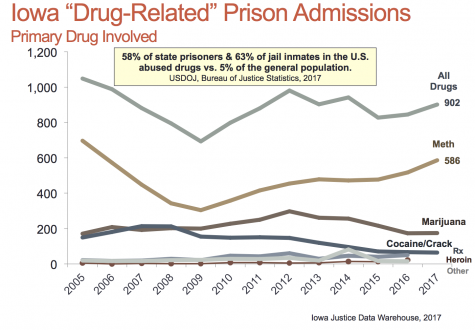December 11, 2018
While the number of labs has significantly decreased from 1,500 labs in 2004 to only 36 labs in 2017, dangers still lurk. Woolery explained that the legislature reduced the demand for homemade and domestic supplies of methamphetamine, but this caused users to search for illicit drugs from other outlets.
“The foreign supply smuggled into the state is the purest form it’s ever been, which makes it more accessible and available,” Woolery said. “There’s more of it and is relatively inexpensive, so buying that on the black market for someone who is addicted may be a lower risk proposition than making it.”
Woolery added that even in 2004, law enforcement officials told him that over 80 percent of the meth in Iowa came from Mexico. Most is for personal use in small labs, but big volumes are transported into Iowa by different methods of transportation.
“Meth is symbolic of a lot of other threats in the country,” Komendowski said. “We’ve done everything in Iowa we can to reduce the availability of meth, and yet it still finds a way here. It’s nefarious.”

But there’s one good thing about being located in the middle of the country. Tyler Schneider, who works for the Johnson County Sheriff’s Office and serves on the Johnson County Drug Task Force, said that while Iowa City and surrounding areas rely on foreign suppliers for methamphetamine, the location has decreased the amount of drugs being smuggled in. Counties closer to the Mississippi River and the Chicago area have a higher risk of drug trafficking.
Still, Schneider noted that the majority of crimes committed in Johnson County done while under the influence of methamphetamine revolve around burglary and theft. Users acquire goods that they can sell in order to have money to buy more drugs, and often pawn and sell items to support the habit.
Lowe’s stepbrother ended up in jail several times due to selling methamphetamine.
“We found out he was hiding meth behind our house because he resorted to selling it,” Lowe said. “We had to ask him to stay away. He went back and forth to jail, got another user pregnant, and was homeless for a while.”
While the numbers of arrests and methamphetamine busts have decreased, the drug still lurks.
Woolery said that around 90 percent of harm reduction, or stopping the use and production of methamphetamine, has taken place in Iowa, but the ultimate goal is to hit total reduction.
“We are pleased that we’ve had that degree of progress on this front,” Woolery said. “The big challenge that remains is the addiction piece.”